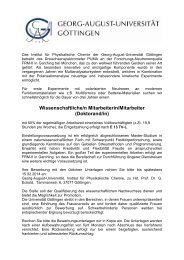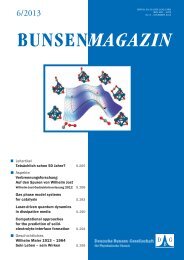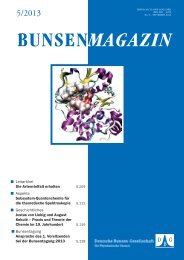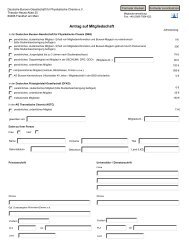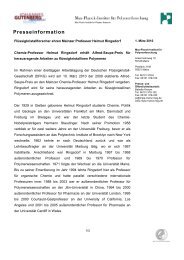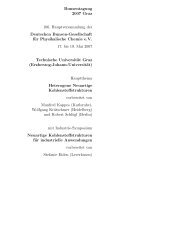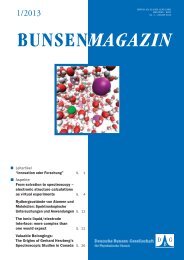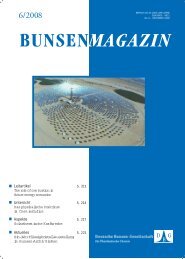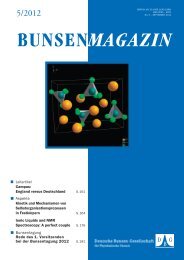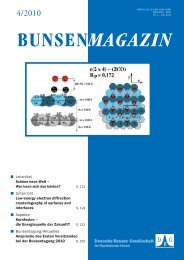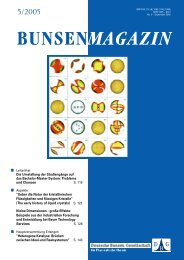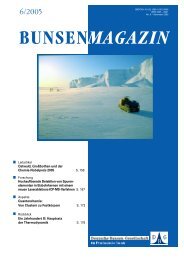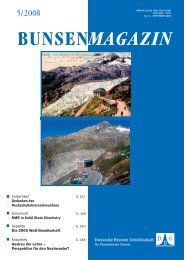BUNSENMAGAZIN - Deutsche Bunsengesellschaft für ...
BUNSENMAGAZIN - Deutsche Bunsengesellschaft für ...
BUNSENMAGAZIN - Deutsche Bunsengesellschaft für ...
Sie wollen auch ein ePaper? Erhöhen Sie die Reichweite Ihrer Titel.
YUMPU macht aus Druck-PDFs automatisch weboptimierte ePaper, die Google liebt.
DEUTSCHE BUNSEN-GESELLSCHAFT<br />
Figure 15: Molecular recognition of solvent molecules in calix[4]hydrochinone-based nanotubular assemblies. 64<br />
Since only one of the two hydrogen-bond acceptor sites is used<br />
within the tubes, the free coordination site is available for molecular<br />
recognition of solvents. We could demonstrate that (mono-)<br />
alcohols are preferably bound even in the presence of acetone<br />
which is a suitable solvent for the nanotubes. The presence of<br />
the respective solvent molecule within the assembly is clearly<br />
revealed by characteristic shifts of the corresponding solvent 1 H<br />
NMR signal. Notably, compared to the free solvent, incorporated<br />
molecules experienced substantial downfi eld shifts (even to<br />
negative ppm values) which could be rationalized with the help<br />
of a so-called Nuclear Independent Chemical Shift (NICS) 63 map<br />
obtained from an ab initio DFT computation. 23 Though acetone<br />
facilitates formation of such nanotubes, it can be completely<br />
replaced by 2-methyl-2-propanol or 2-propanol, while cyclohexanone<br />
is rather poorly and pyridine not at all incorporated. This<br />
fi nding particularly emphasizes that molecular recognition does<br />
not solely rely on the mere presence of suitable functional<br />
groups but also on additional factors like van-der-Waals forces<br />
or mobility of the respective guest molecule. 64<br />
Selectivity on a molecular level also constitutes the basis of<br />
specifi c functions of natural receptors. Due to the size and<br />
complexity of the objects of interest, much insight can be<br />
gained on rather simple model compounds. Therefore, based<br />
on tweezer complexes 65 that form host-guest structures with<br />
electron-defi cient aromatic guests (“molecular pincettes”), we<br />
UNTERRICHT<br />
studied the infl uence of hydrogen-bonding and p-p-interaction<br />
to neighbouring molecules on the respective 1 H chemical shifts<br />
of the guest molecules. Unambiguous peak assignment and interpretation<br />
of the 1 H MAS spectra of such complexes is based<br />
on both 1 H- 1 H DQ MAS and 1 H- 13 C chemical shift correlation<br />
spectra as well as ab initio chemical shift computations at high<br />
level of theory employing a so-called linear scaling method. 66 In<br />
order to accurately predict the respective 1 H chemical shifts of<br />
the complexes, packing effects had to be taken into account,<br />
thus refl ecting perturbing local fi elds present at the site of the<br />
guest molecule. Indeed, the power of a combined experimental<br />
and computational approach is increasingly applied in the fi eld<br />
of “NMR crystallography” 67 where inter- and intramolecular<br />
1 H- 1 H distances or 1 H chemical shifts (derived from NMR) are<br />
used as input for computational methods.<br />
3.3. COLUMNAR STRUCTURES<br />
In addition to hydrogen-bonding, the 1 H chemical shifts are<br />
very sensitive to ring currents associated with p-electrons in<br />
aromatic moieties. 68 While in solution, the isotropic molecular<br />
tumbling removes most of the p-shifts, the protons are exposed<br />
to the p-electrons of nearby either intra- or intermolecular aromatic<br />
moieties in the solid. The latter information is particularly<br />
valuable for elucidating supramolecular structures. 69 Indeed,<br />
Figure 16: Molecular tweezer complex with tetracyanobenzene guest: 1 H- 1 H double-quantum MAS NMR spectrum at 700 MHz and 30 kHz MAS. Selected<br />
slices reveal the correlation peaks among the resonances at (a) 4.1 and 2.0 ppm, (b) 7.0 and 2.0 ppm and (c) 7.0 and 4.1 ppm, respectively. 66<br />
69



